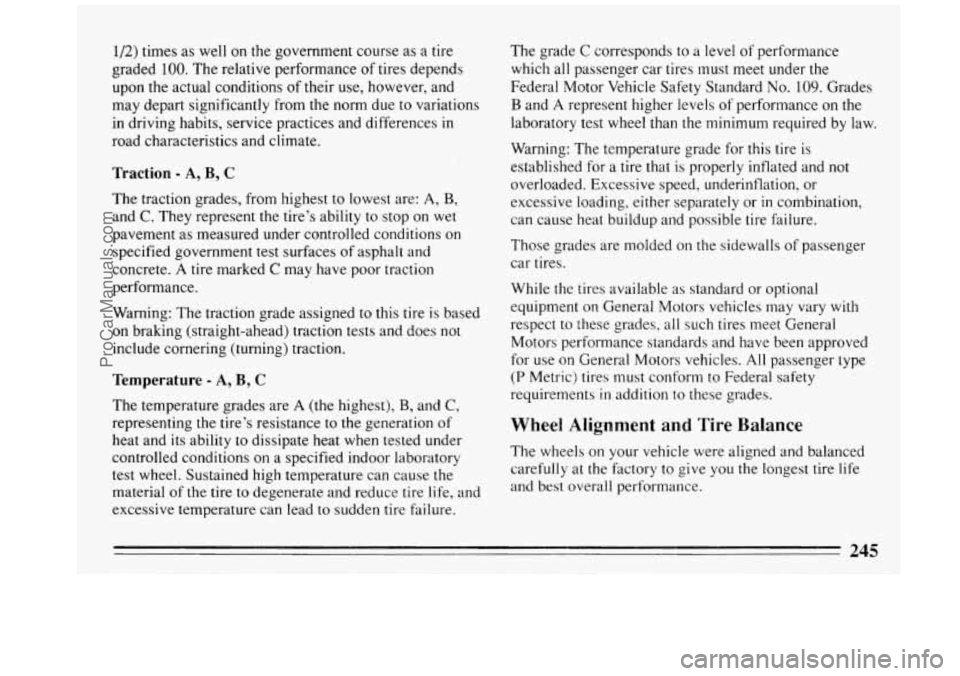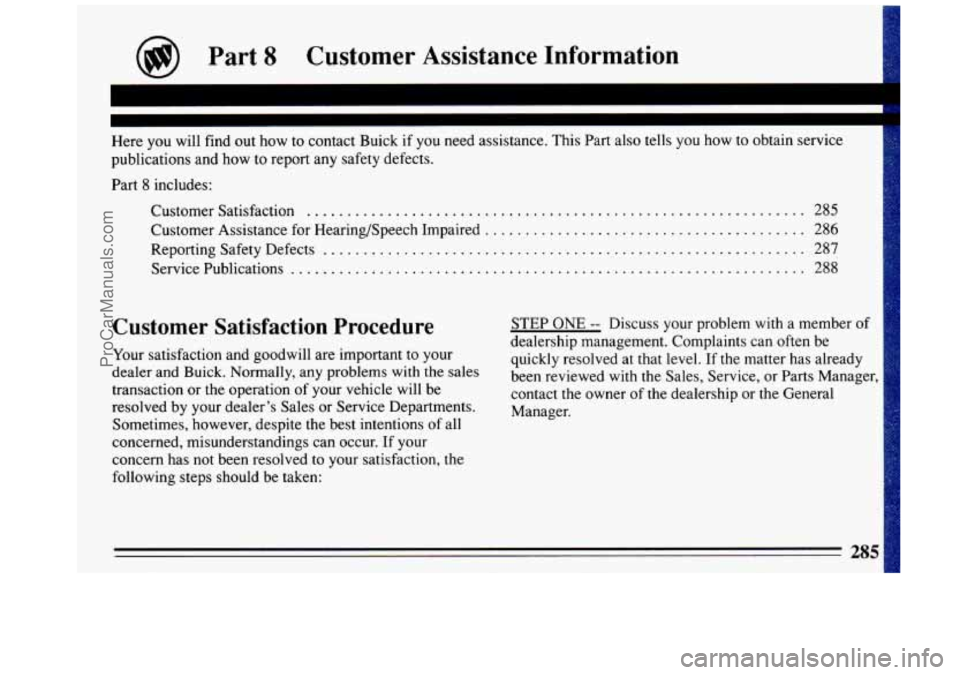Page 244 of 308
When to Check: Check your tires once a month or
more.
Don’t forget your compact spare tire. It should be at
60
psi (420 kPa).
How to Check: Use a good quality pocket-type gage to
check tire pressure. Simply looking at the tires will not
tell
you the pressure, especially if you have radial tires --
which may look properly inflated even if they’re
underinflated.
If your tires have valve caps, be sure to put them back
on.
They help prevent leaks by keeping out dirt and
moisture.
Tire Inspection and Rotation
To make your tires last longer, have them inspected and
rotated at the mileages recommended
in the
Maintenance Schedule. See “Scheduled Maintenance
Services”
in the Index.
I
I‘
Use this rotation pattern.
After the tires have been rotated, adjust the front and
rear inflation pressure
as shown on the Tire-Loading
Information label. Make certain that all wheel nuts are
properly tightened. See “Wheel Nut Torque”
in the
Index.
242
ProCarManuals.com
Page 247 of 308

1/2) times as well on the government course as a tire
graded
100. The relative performance of tires depends
upon the actual conditions of their use, however, and
may depart significantly from the norm due to variations
in driving habits, service practices and differences
in
road characteristics and climate.
Traction - A, B, C
The traction grades, from highest to lowest are: A, B,
and C. They represent the tire’s ability to stop on wet
pavement as measured under controlled conditions on
specified government test surfaces of asphalt and
concrete.
A tire marked C may have poor traction
performance.
Warning: The traction grade assigned to this tire
is based
on braking (straight-ahead) traction tests and does not
include cornering (turning) traction.
Temperature - A, B, C
The temperature grades are A (the highest), B, and C,
representing the tire’s resistance to the generation of
heat and its ability to dissipate heat when tested under
controlled conditions on a specified indoor laboratory
test wheel. Sustained high temperature can cause the
material
of the tire to degenerate and reduce tire life, and
excessive temperature can lead to sudden tire failure. The
grade
C corresponds to a level of performance
which all passenger car tires must meet under the
Federal Motor Vehicle Safety Standard
No. 109. Grades
B and A represent higher levels of performance on the
laboratory test wheel than the minimum required by law.
Warning: The temperature grade for this tire
is
established for a tire that is properly inflated and not
overloaded. Excessive speed, underinflation, or
excessive loading, either separately or
in combination,
can cause heat buildup and possible tire failure.
These grades are molded
on the sidewalls of passenger
car tires.
While the tires available
as standard or optional
equipment
on General Motors vehicles may vary with
respect to these grades, all such tires meet General
Motors performance standards and have been approved
for use on General Motors vehicles. All passenger type
(P Metric) tires must conform to Federal safety
requirements
in addition to these grades.
Wheel Alignment and Tire Balance
The wheels on your vehicle were aligned and balanced
carefully at the factory to give
you the longest tire life
and best overall performance.
245
ProCarManuals.com
Page 284 of 308
Section E: Maintenance Record
After the scheduled services are performed, record the
date, odometer reading and who performed the service
in the columns indicated. When completing the
Maintenance Performed column, insert the numbers from
the Schedule I or Schedule I1 maintenance charts
which correspond
to the maintenance performed. Also,
you should retain all maintenance receipts. Your owner
information portfolio is a convenient place to store
them.
Maintenance Record
282
ProCarManuals.com
Page 287 of 308

@ Part 8 Customer Assistance Information
~ ~~~~~ ~
Here you will find out how to contact Buick if you need assistance. This Part also tells you how to obtain service
publications and how to report any safety defects.
Part 8 includes:
Customer Satisfaction
.............................................................. 285
Customer Assistance for Hearing/Speech Impaired
........................................ 286
Reporting Safety Defects
............................................................ 287
ServicePublications
................................................................ 288
Customer Satisfaction Procedure
Your satisfaction and goodwill are important to your
dealer and Buick. Normally, any problems with the sales
transaction or the operation
of your vehicle will be
resolved by your dealer’s Sales or Service Departments.
Sometimes, however, despite the best intentions
of all
concerned, misunderstandings can occur.
If your
concern has not been resolved
to your satisfaction, the
following steps should be taken:
STEP ONE -- Discuss your problem with a member of
dealership management. Complaints can often be
quickly resolved at that level.
If the matter has already
been reviewed with the Sales, Service, or Parts Manager,
contact the owner
of the dealership or the General
Manager.
285
ProCarManuals.com